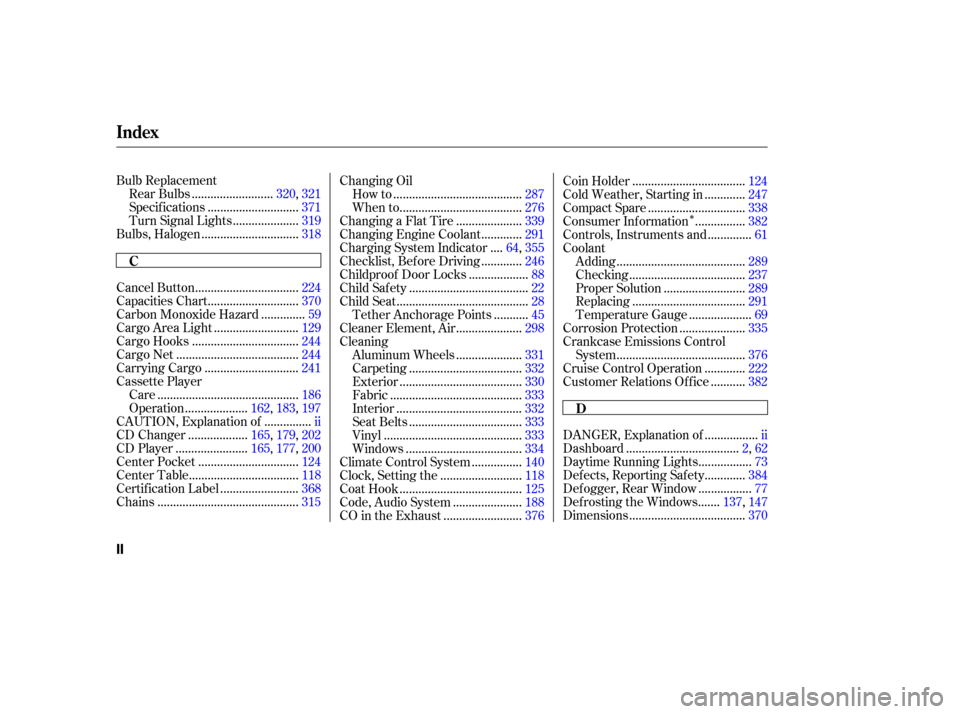Page 358 of 399
This indicator should come on when
the ignition switch is ON (II), and go
out af ter the engine starts. If it
comes on brightly when the engine
is running, it indicates that the
charging system has stopped
charging the battery.By eliminating as much of the
electrical load as possible, you can
drive several miles (kilometers)
before the battery is too discharged
to keep the engine running. Drive to
a service station or garage where
you can get technical assistance.
Immediately turn of f all electrical
accessories:radio,heater,A/C,
climate control, rear def ogger, cruise
control, etc. Try not to use other
electrically-operated controls such as
the power windows. Keep the engine
running and take extra care not to
stall it. Starting the engine will
discharge the battery rapidly.
Charging System Indicator
T aking Care of t he Unexpect ed355
C CH
H A
AR
RGGI INNG G S
SYYSSTTE
EM
M I
INND DI
ICCA A T
TO
OR R
Page 375 of 399

�µ
The treadwear grade is a compara-
tive rating based on the wear rate of
the tire when tested under controlled
conditions on a specif ied government
test course. For example, a tire
graded 150 would wear one and one-
half (1 1/2) times as well on the
government course as a tire graded
100. The relative perf ormance of
tires depends upon the actual condi-
tions of their use, however, and may
depart signif icantly f rom the norm
due to variations in driving habits,
service practices and dif f erences in
road characteristics and climate. The traction grades, f rom highest to
lowest, are AA, A, B, and C. Those
grades represent the tire’s ability to
stop on wet pavement as measured
under controlled conditions on
specif ied government test surf aces
of asphalt and concrete. A tire
marked C may have poor traction
perf ormance.
The tires on your vehicle meet all
U.S. Federal Saf ety Requirements.
All tires are also graded f or
treadwear, traction, and temperature
perf ormance according
to Department of Transportation
(DOT) standards. The f ollowing
explains these gradings.
Quality grades can be f ound where
applicable on the tire sidewall
between the tread shoulder and the
maximum section width. For
example:
Warning: The traction grade
assignedtothistireisbasedon
straight-ahead braking traction tests,
and does not include acceleration,
cornering, hydroplaning, or peak
traction characteristics.
T echnical Inf ormation
DOT T ire Quality Grading (U.S. Vehicles)
Treadwear
Traction AA, A, B, C
Unif orm T ire Quality Grading T readwear 200
Traction AA
Temperature A
372
Page 379 of 399

�Î
�ÎThe burning of gasoline in your
vehicle’s engine produces several by-
products. Some of these are carbon
monoxide (CO), oxides of nitrogen
(NOx) and hydrocarbons (HC).
Gasoline evaporating f rom the tank
also produces hydrocarbons. Con-
trolling the production of NOx, CO,
and HC is important to the environ-
ment. Under certain conditions of
sunlight and climate, NOx and HC
react to f orm photochemical ‘‘smog.’’
Carbon monoxide does not contri-
bute to smog creation, but it is a
poisonous gas. The United States Clean Air Act
sets standards f or automobile
emissions. It also requires that
automobile manufacturers explain to
owners how their emissions controls
workandwhattodotomaintain
them. This section summarizes how
the emissions controls work.
Scheduled maintenance is on page
.
In Canada, Honda vehicles comply
with the Canadian Motor Vehicle
Saf ety Standards (CMVSS) f or
Emissions valid at the time they are
manuf actured.
Your vehicle has a Positive
Crankcase Ventilation System. This
keeps gasses that build up in the
engine’s crankcase f rom going into
the atmosphere. The Positive Crank-
case Ventilation valve routes them from the crankcase back to the
intake manif old. They are then
drawn into the engine and burned.
As gasoline evaporates in the f uel
tank, an evaporative emissions
control canister f illed with charcoal
adsorbs the vapor. It is stored in this
canister while the engine is of f . Af ter
the engine is started and warmed up,
the vapor is drawn into the engine
and burned during driving.
The Onboard Ref ueling Vapor
Recovery (ORVR) system captures
the f uel vapors during ref ueling. The
vapors are adsorbed in a canister
f illed with activated carbon. While
driving, the f uel vapors are drawn
into the engine and burned of f .
276
The Clean Air Act
Crankcase Emissions Control
System Evaporative Emissions Control
System
Onboard Ref ueling Vapor
Recovery
T echnical Inf ormation
Emissions Cont rols
376
Page 391 of 399

�Î
Bulb Replacement.........................
Rear Bulbs .320, 321
............................
Specif ications .371
....................
Turn Signal Lights . 319
..............................
Bulbs, Halogen .318
................
DANGER, Explanation of . ii
...................................
Dashboard .2, 62
................
Daytime Running Lights . 73
............
Def ects, Reporting Saf ety . 384
................
Def ogger, Rear Window . 77
......
Def rosting the Windows . 137,147
....................................
Dimensions .370
................................
Cancel Button .224
............................
Capacities Chart .370
.............
Carbon Monoxide Hazard . 59
..........................
Cargo Area Light .129
.................................
Cargo Hooks .244
......................................
Cargo Net .244
.............................
Carrying Cargo .241
Cassette Player ............................................
Care .186
...................
Operation . 162,183,197
..............
CAUTION, Explanation of . ii
..................
CD Changer . 165,179,202
......................
CD Player .165, 177,200
...............................
Center Pocket .124
..................................
Center Table .118
........................
Certif ication Label .368
............................................
Chains .315 Changing Oil
........................................
How to .287
......................................
When to .276
....................
Changing a Flat Tire .339
............
Changing Engine Coolant . 291
...
Charging System Indicator . 64,355
............
Checklist, Bef ore Driving . 246
..................
Childproof Door Locks . 88
.....................................
Child Saf ety .22
.........................................
Child Seat .28
..........
Tether Anchorage Points . 45
....................
Cleaner Element, Air . 298
Cleaning ....................
Aluminum Wheels .331
...................................
Carpeting .332
......................................
Exterior .330
.........................................
Fabric .333
.......................................
Interior .332
...................................
Seat Belts .333
...........................................
Vinyl .333
....................................
Windows .334
...............
Climate Control System . 140
.........................
Clock, Setting the .118
......................................
Coat Hook .125
.....................
Code, Audio System .188
........................
CO in the Exhaust .376 ...................................
Coin Holder .124
............
Cold Weather, Starting in . 247
..............................
Compact Spare .338
...............
Consumer Inf ormation . 382
.............
Controls, Instruments and . 61
Coolant ........................................
Adding .289
....................................
Checking .237
.........................
Proper Solution .289
...................................
Replacing .291
...................
Temperature Gauge . 69
....................
Corrosion Protection .335
Crankcase Emissions Control ........................................
System .376
............
Cruise Control Operation . 222
..........
Customer Relations Of f ice . 382
Index
C
D
II
Page:
< prev 1-8 9-16 17-24